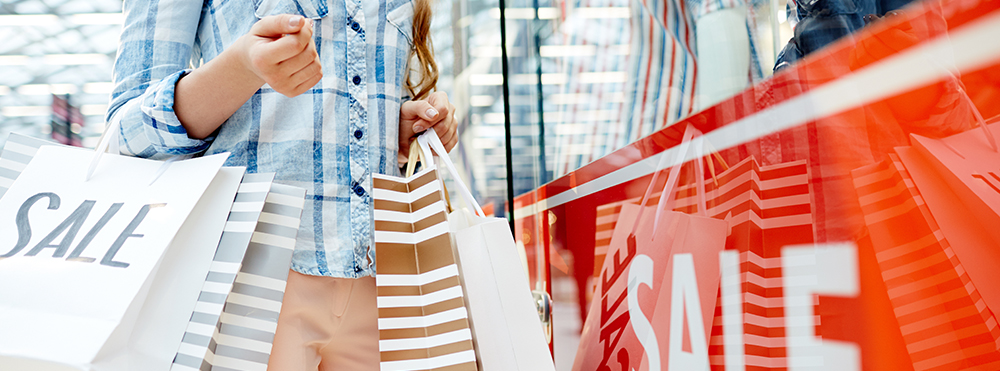The power of the sale

Australian shoppers are readying for some of the most anticipated sales periods of the year, with this month’s Black Friday gaining popularity to join Boxing Day as one of the top three discount periods that consumers seek to enjoy.
Not only will these sales periods see shoppers on the hunt for specific items at a discount price, research by PayPal indicates they will drive additional purchasing behaviour with 7 in 10 Australians always on the lookout for a bargain.
Here’s an insight into Australia’s love of saving and how retailers live up to the bargain expectation.
Australia ‘On Sale’
Earlier this year, e-commerce giant PayPal examined Australia shoppers’ desire to nab a bargain, noting 7 in 10 consumers were always on the lookout for sale, while well over half (58 per cent) had bought a product on impulse simply because it was reduced.
The report also found much of this hunt for price reductions occurred online, with mobile often the device of choice when it comes to seeking and finding a bargain.
While Aussie shoppers love a bargain, retail is a major fan of sales periods too. The report noted more than half of the retailers it surveyed (53 per cent) said sales attracted new customers, two-in-five (39 per cent) stated sales increased revenue and 25 per cent noted customers buy more than normal during sale times.
Australia’s prime sales times
Boxing Day and EOFY rank as Australian shoppers’ most anticipated sales events, with 44 per cent of consumers indicating they participate in each of these annual sales.
Next comes Black Friday, with PayPal’s research indicating more and more Australians are now taking part in this American-inspired event. A third (33 per cent) of shoppers were expecting to nab a bargain on Black Friday, which this year falls on November 29. That sees Black Friday’s popularity in line with mid-season sales.
The January sales are next on the list with 21 per cent of consumers expecting to take part. Meanwhile, other American-based trends like Cyber Monday (December 2) are also moving up the ranks, with 17 per cent set to take part. A similar Australian event known as Click Frenzy also attracts the same amount of patronage.
Back to School comes in at number eight, with 11 per cent of consumers participating, followed by Afteryay (six per cent) and Amazon Prime Day (six per cent).
Sales spending

Not only do sales drive specific purchases, but they also result in impulse buys, the report explained, with 58 per cent of shoppers noting they made an impulse decision to buy something in the last quarter simply because it was reduced.
In addition, more than one-third of Australians (37 per cent) bought a brand online they wouldn’t usually buy because it was on sale and one-third (34 per cent) have also bought items they didn’t need because of a sale.
Meanwhile, the average shopper bought 2.7 items and spent $108 without planning to on discounted items. Gen Y are the biggest sale-driven impulse spenders, with 3.6 items costing on average $145.
How consumers shop
It’s no surprise that the hunt for a bargain starts online, with 57 per cent of shoppers indicating they shop the sales over the internet.
That said, 51 per cent still shop at a bricks and mortar store.
When it comes to the device used, shoppers are increasingly mobile, and this is especially prevalent in the younger generations.
The report found one-in-five consumers (20 per cent) use their mobiles to keep up with all the different sales. Similarly, one-in-five Australians (21 per cent) have made an impulse purchase after receiving a push notification or email on their mobile about a sale.
How retail meets the expectation
Interestingly although shoppers anticipate spending at the sales, often retailers do not quite live up to expectation.
For example:
- Only 30 per cent of retailers expect to participate in Boxing Day sales
- 26 per cent of retailers expect to participate in EOFY
- 25 per cent of retailers expect to participate in Black Friday
“Consumer participation in sale periods is higher (73 per cent) than retailer participation (59 per cent),” the report notes.
The key takeaway
Australians love a bargain, in fact, they actively seek it, with sales-driving increased spending and unexpected purchases.
However, retailers planning a sale need to leverage the online realm, and if they’re targeting the younger generation that experience needs to be mobile optimised.
Meanwhile, the report also notes retailers have an opportunity beyond traditional sales, suggesting retailers should:
“Balance participating in tradition sales periods (e.g. Boxing Day) with unique sales moments for your brand. Set clear objectives and promote sales effectively where potential customers already are, such as social platforms like Instagram.”